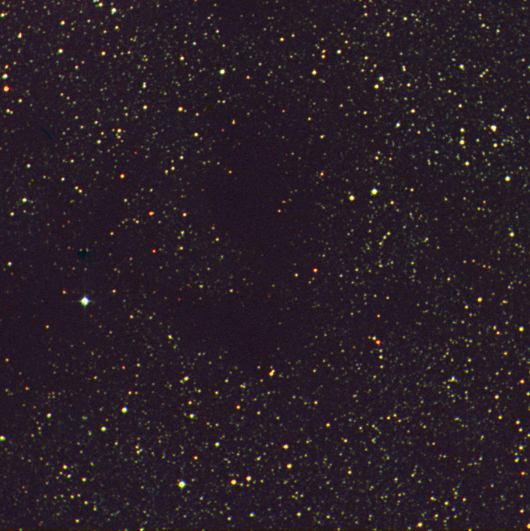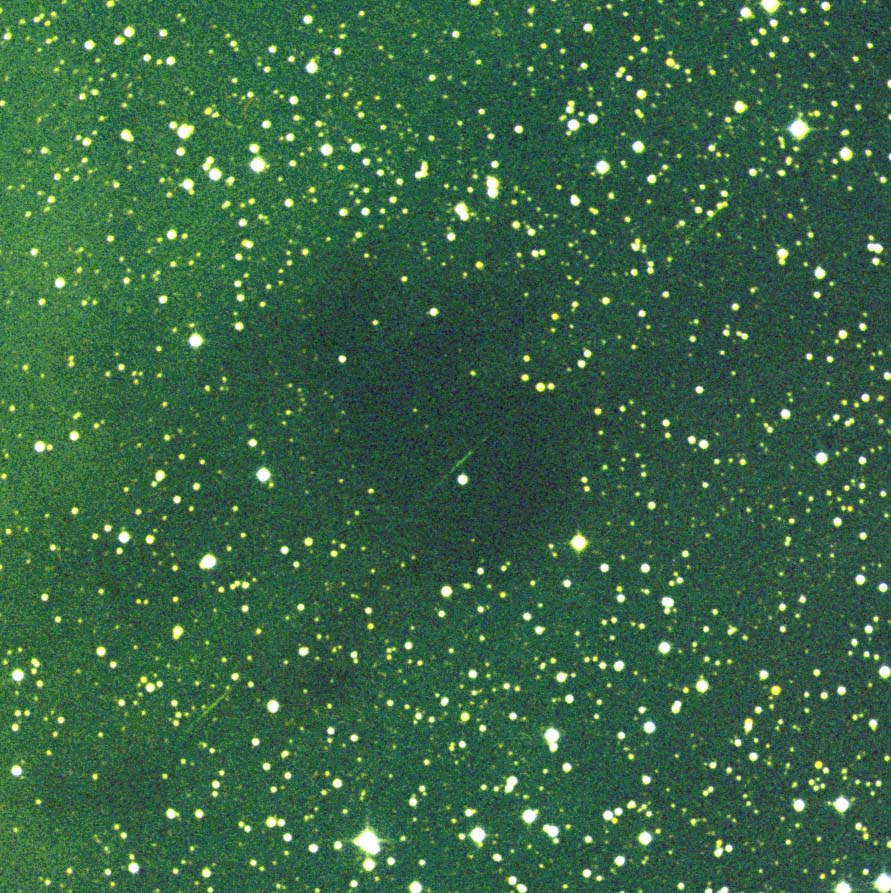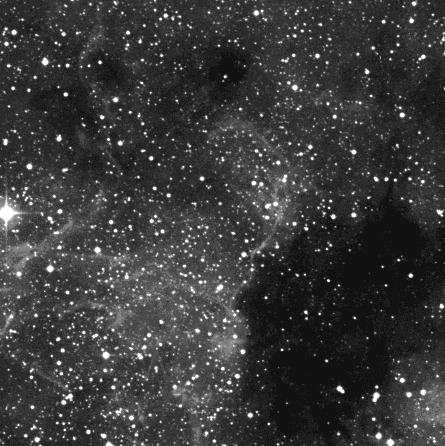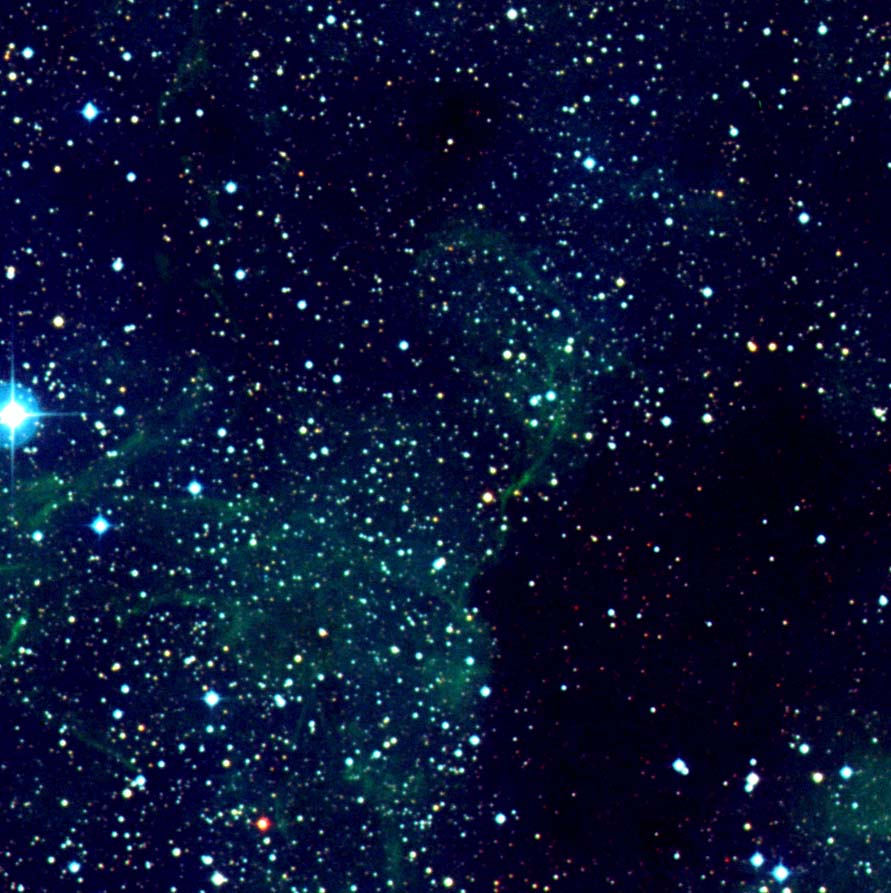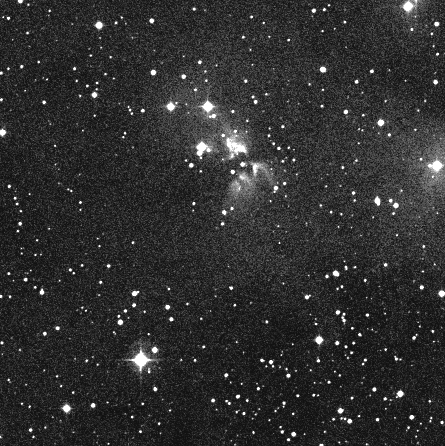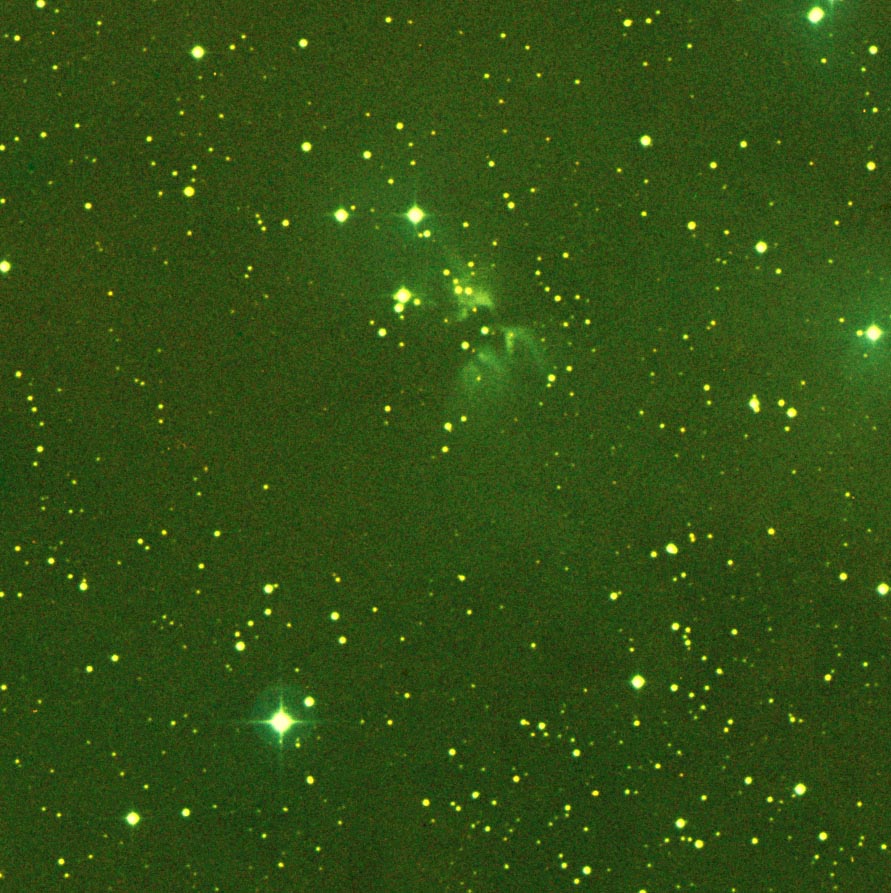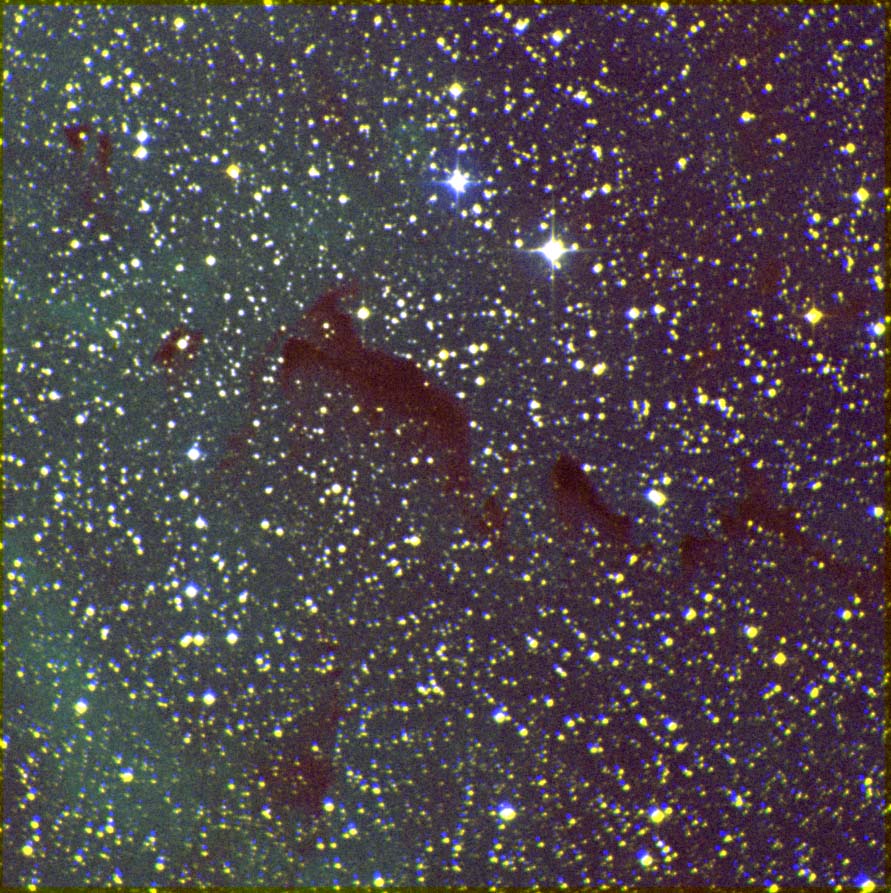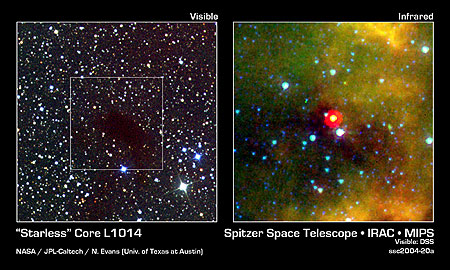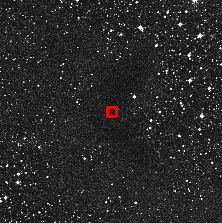Difference between revisions of "Lynds Target Selection"
m |
|||
| (62 intermediate revisions by 6 users not shown) | |||
| Line 7: | Line 7: | ||
| − | My original thoughts on good targets were the following three: | + | My original thoughts on good targets were the following three: LDN 470, LDN 1225, LDN 880 (but maybe too diaphanous). And, at the AAS, you guys also came up with LDN 1340. |
| − | |||
| − | |||
| − | |||
| − | And, at the AAS, you guys also came up with | ||
| − | |||
=General information re: lists of targets= | =General information re: lists of targets= | ||
| Line 49: | Line 44: | ||
[[image:ldn470possred.gif]] LDN 470 in POSS-red. image is 0.25 deg on a side. --[[User:Rebull|Rebull]] 14:09, 14 January 2008 (PST) | [[image:ldn470possred.gif]] LDN 470 in POSS-red. image is 0.25 deg on a side. --[[User:Rebull|Rebull]] 14:09, 14 January 2008 (PST) | ||
| − | + | --[[User:Mcdonald|Mcdonald]] 15:39, 15 January 2008 (PST) Hi, here is a colored image of LDN 470: | |
[[Image:ldn470.jpg]] | [[Image:ldn470.jpg]] | ||
| Line 56: | Line 51: | ||
[[image:ldn1225possred.gif]] LDN 1225 in POSS-red. image is 0.25 deg on a side. --[[User:Rebull|Rebull]] 14:09, 14 January 2008 (PST) | [[image:ldn1225possred.gif]] LDN 1225 in POSS-red. image is 0.25 deg on a side. --[[User:Rebull|Rebull]] 14:09, 14 January 2008 (PST) | ||
| − | + | --[[User:Mcdonald|Mcdonald]] 15:44, 15 January 2008 (PST) Here is a 15 arcmin x 15 arcmin colored image of ldn1225: | |
[[Image:ldn1225.jpg]] | [[Image:ldn1225.jpg]] | ||
| Line 67: | Line 62: | ||
--[[User:Rebull|Rebull]] 14:43, 14 January 2008 (PST) | --[[User:Rebull|Rebull]] 14:43, 14 January 2008 (PST) | ||
| − | + | --[[User:Mcdonald|Mcdonald]] 15:47, 15 January 2008 (PST) Here is John's colored image made in Austin again 15 x 15 arcmin: | |
[[Image:LDN880 by John.jpg]] | [[Image:LDN880 by John.jpg]] | ||
| Line 101: | Line 96: | ||
[END] | [END] | ||
| − | + | --[[User:Mcdonald|Mcdonald]] 15:51, 15 January 2008 (PST) 15 x 15 colored image: | |
[[Image:ldn1340.jpg]] | [[Image:ldn1340.jpg]] | ||
| Line 118: | Line 113: | ||
[END] | [END] | ||
| − | + | --[[User:Mcdonald|Mcdonald]] 15:54, 15 January 2008 (PST) A 15 x 15 arcmin colored image: | |
[[Image:ldn951.jpg]] | [[Image:ldn951.jpg]] | ||
| Line 136: | Line 131: | ||
--[[User:Rebull|Rebull]] 10:48, 15 January 2008 (PST) Out of David's top 16 suggestions, the only ones wihtout existing spitzer data are ldn | --[[User:Rebull|Rebull]] 10:48, 15 January 2008 (PST) Out of David's top 16 suggestions, the only ones wihtout existing spitzer data are ldn | ||
1357 (right on the edge of some existing spitzer data) and ldn 1358. you must be doing something right, as you're hitting popular objects. ;) [END] | 1357 (right on the edge of some existing spitzer data) and ldn 1358. you must be doing something right, as you're hitting popular objects. ;) [END] | ||
| + | |||
| + | --[[User:Rebull|Rebull]] 14:19, 21 January 2008 (PST) but really from jan 20: tim sent this in email: | ||
| + | I have been doing some looking at the Lynds targets. I'm attaching pics of LDN 1598 and LDN 1340. | ||
| + | I could not find anything in ADS about either of these targets, so it looks like they have not been | ||
| + | studied a great deal. I like the fact that you have a dark area next to a fairly rich star field | ||
| + | (especially with 1598). This would tend to indicate a dense nebulous area. the images are 5'x5'. (targets suggested by Tim Spuck) | ||
| + | here's the graphics: (L1598 first, then L1340): | ||
| + | [[image:tim_l1598.jpg]] [[image:tim_l1340.jpg]] | ||
| + | |||
| + | --[[User:Rebull|Rebull]] 14:26, 21 January 2008 (PST) actually, i get 19 references for ldn 1598, and 15 for L1340, both using simbad... [END] | ||
| + | |||
| + | --[[User:Spuck|Spuck]] 05:37, 22 January 2008 (PST) Luisa, just for future reference, I thought ADS was a more complete database for identification of current research. I assume this is not the case since you found many references in simbad. Is that correct? Thanks, Tim [END] | ||
| + | |||
| + | --[[User:Spuck|Spuck]] 06:57, 22 January 2008 (PST) Ok ... I think I may have answered part of my question. I was seaching on LDN1598 and coming up with nothing, but if I search on L1598 or L1340 I am at least coming up with something in ADS (one for 1598, and seven for L1340). I need to play with the parameters a bit. [END] | ||
| + | |||
| + | --[[User:Rebull|Rebull]] 17:57, 22 January 2008 (PST) they're different sorts of databases, with different strengths and weaknesses. ADS is driven by the literature itself, whereas SIMBAD is driven more by object lists. ADS is usually more complete. But, for example, some of the references for L1685 don't actually call it L1685 anywhere in the paper. ADS may or may not have the information that those papers really do have data about that object - sometimes ADS knows, and sometimes ADS doesn't. Someone at the SIMBAD end did realize (or at least THINKS) that the objects are the same, and has (hopefully correctly) tied the object to the paper. SIMBAD often requires a human to make the association between synonyms for certain objects, and this can be fallible, especially for the more obscure objects. ADS is generally more accurate in the following sense - SIMBAD may quote a spectral type, but to be sure that whatever object you are looking at really has that type, track down the original papers and make sure that the actual original paper really does cite that type. More obscure papers are rarely in SIMBAD, but they can be found in ADS. ADS and SIMBAD are heavily interlinked, so there's a lot of ways to get between them. [END] | ||
| + | |||
| + | --[[User:Dewolf|Dewolf]] 22 Jan 2008 10:19:06 (question submitted via regular email): I'd seen some images [before] with the large pixel areas as well. How do you find a potential IRAS source in a small LDN with such poor resolution? [END] | ||
| + | |||
| + | --[[User:Rebull|Rebull]] 10:19, 22 January 2008 (PST): | ||
| + | Your question really has a two-part answer. | ||
| + | |||
| + | The first part is that I'm not detecting sources by eye. I'm relying upon the computer-generated IRAS Point Source Catalog (PSC) and Faint Source Catalog (FSC) which are described along with the rest of the IRAS mission | ||
| + | information here: http://irsa.ipac.caltech.edu/IRASdocs/iras.html | ||
| + | |||
| + | If you get into the documentation, you will find that the catalog consists of, among other things, measurements at each of the 4 IRAS wavelengths, and a quality flag for each of the 4 bands. This quality flag is REALLY | ||
| + | IMPORTANT, as it tells us whether the computer thought it was a real detection at each band, or just an upper limit at a particular band. Because the resolution of IRAS is so poor, indeed, it can be fooled. | ||
| + | |||
| + | One of the objects in our shortlist below really did have a recognizable clear point source right on the center of the object at 25 um. But, the rest, I agree, I'd be hard-pressed to identify the source by eye. That doesn't mean it's not there, however. The computer is really good at finding real, faint sources. When we go to write this up, we really should pay attention to whether the computer felt it was a point source just at 100 um and not at 12 or 25 um. For this subset of objects, I am cheating a little because several of them have observations at other wavelengths, enough so that I know there's a real source there, so I didn't go check the quality flags for those objects. | ||
| + | |||
| + | The second aspect of the answer is that when we go look with Spitzer, it could very well be that the source dissolves away into background nebulosity, or breaks into pieces. We have an image at 24 um of something in the Perseus star-forming region that appears in the IRAS catalog as a single object, IRAS 03388+3139. But, when we look with Spitzer, it breaks up into 9 objects. This stuff appeared in Rebull et al., 2007, ApJS, 171, 447 (also findable in astro-ph, look near Jan 2007), along with an analysis of what IRAS sources dissolved away completely into nebulosity when viewed with Spitzer. The nebulosity is very complex here, so it happens. | ||
| + | [END] | ||
| + | |||
| + | =A (The?) Shortlist= | ||
| + | |||
| + | Goal: find anywhere from one to a few LDN likely to host young stars so that we not only have a pretty picture but also find some new baby stars. If we are going to ask for more than one cloud, they need to have different properties, so that we can explain that we are looking at THIS sort and THAT sort to compare. And we can (should) also say we will mine the Spitzer archive for more examples. | ||
| + | |||
| + | ==Luisa's Favorites== | ||
| + | |||
| + | {| border="1" | ||
| + | |LDN | ||
| + | |Image | ||
| + | |Notes | ||
| + | |- | ||
| + | |951 | ||
| + | |[[image:ldn951_possred.jpg]] (POSS/Red, 0.25 deg on side) | ||
| + | | | ||
| + | * from cris (see above.) | ||
| + | * opacity class 6 (good, deep and dark) | ||
| + | * 'linear' (as opposed to 'blobby') | ||
| + | * (Visser et al. 2002, AJ, 124, 2756) part of the cygnus rift, 700 pc away, max extinction Av=10, just 4.7 Msun in cloud | ||
| + | * IRAS source 21186+4320 | ||
| + | * (ref?) two submm 'starless cores' here : in 1950 coordinates 21:18:20 +43:19:17 and 21:18:22.9 +43:19:51 -> we might not find anything, but we might find some of the youngest stars forming here. | ||
| + | * visible to spitzer through tomorrow 1/22 (argh!); next window june 27-sep 10. | ||
| + | *IRAC total time 907 sec, MIPS total time 3313 seconds. IRAC: [[media:ldn951_withirac.gif]] (irac has two fields of view, portrayed by the two colors; the region covered by both colors is the region we'll get with all 4 irac bands [3.6, 4.5, 5.8, and 8 um]. note that the specific portion of sky that we will cover rotates, so these observations are designed to catch as much of the LDN as i can and still be independent of rotation angle.) MIPS: [[media:ldn951_withmips.gif]] (MIPS has 3 cameras, but we're only using 2 -- indicated by the two colors, 24 and 70 um. | ||
| + | * with irac we will see mostly stars, some nebulosity. we need at least MIPS-24, which is 1191 seconds of the 3313 seconds; mips 24 will help us find stars, but also find the nebulosity. in this specific case, where we have some submm cores, mips70 is important too, as it might be just at mips70 that we see these submm cores. note that i get a little too much sky at 24 and not quite enough at 70; i'm constrained by the choices i have in the AOR construction, and i'm optimizing for science and time, not necessarily a pretty picture. | ||
| + | *TOTAL TIME: 1.2 hrs. (4 IRAC plus 2 MIPS) | ||
| + | |- | ||
| + | |425 | ||
| + | |[[image:ldn425_possred.gif]] (POSS/Red, 0.25 deg on side) | ||
| + | [[image:ldn425_mycenter_possred.gif]] | ||
| + | | | ||
| + | * from cris' ppt based on some subset of my target weeding. | ||
| + | * opacity class 5 (good, pretty deep and dark) | ||
| + | * 'blobby' (as opposed to 'linear') | ||
| + | * Lee and Myers (1999, ApJS, 123, 233) find a YSO here (1950 coords: 17 44 15.4 −04 34 07) | ||
| + | * IRAS source 17442−0433 | ||
| + | * Connelley et al (2007 AJ 133, 1528) find a new NIR reflection nebula here, suggestive that a YSO is illuminating the nebula, and that we will see something pretty at IRAC bands. | ||
| + | * the part that is the center of the coordinates given by lynds (center of image at left) seems offset from the darkest part as seen in POSS. X's in graphic at left are the IRAS point sources in this region; the northernmost one is the one listed in the literature. there is not much to the dark cloud north of the image region shown at left. I'm taking as the center 17:46:55 -04:36:25; see second graphic at left. | ||
| + | * visible to spitzer apr 12-may 23, then sep 21-nov 2. | ||
| + | * IRAC total time 657 seconds ([[media:ldn425_mycenter_possred_withirac.gif]]) MIPS-24 total time only 395 seconds. Harder to justify 70 um time too here, since it will be expensive and it's not entirely clear what we will see. Could simply plan to jump on the data right away and ask for more time to do 70 if it seems likely to be interesting. ([[media:ldn425_mycenter_possred_withmips.gif]] - box is "my center" for this observation and x's are IRAS sources.) | ||
| + | *TOTAL TIME: 0.3 hrs. (4 IRAC plus 1 MIPS) | ||
| + | |- | ||
| + | |981 | ||
| + | |[[image:ldn981_possred.gif]] (POSS/Red, 0.3 (not 0.25!) deg on side) | ||
| + | | | ||
| + | * from cris' ppt based on some subset of my target weeding. | ||
| + | * opacity class 6 (good, deep and dark) | ||
| + | * 'linear' (as opposed to 'blobby') | ||
| + | * Quanz et al. (2007, ApJ, 656, 287, also astro-ph/0610786 -- see http://arxiv.org/abs/astro-ph/0610786 for free copy of paper) has a very interesting article about the structures around V1331 Cyg, a known YSO. They were studying the immediate environment of this thing using HST, but it is at the end of one of the filaments associated with LDN 981. One of the questions they address in this paper is whether or not V1331 Cyg formed on its own, or with 'friends.' They talk in their paper (see sections 4.2 and 4.3) about whether some objects found in the LDN black parts are real YSOs or not, and they conclude based on available evidence that they are not YSOs. BUT, maybe they just weren't looking in long enough wavelengths. We might find that these stars really are YSOs... or we may not. We may confirm that yes, they are just foreground objects superimposed on the dark lanes of the nebula. V1331 Cyg is just on the edge of the image, to the upper left, at the end of that dark lane, with the funny circular bright nebula (that was what Quanz et al studied with HST). | ||
| + | *[[media:timldn981.jpg| image from tim comparing more wavelengths]] | ||
| + | *[[media:crisldn981.jpg| image from cris comparing scales]] | ||
| + | * visible to Spitzer through jan 27 (argh!), then june 26-feb 3 (not a typo, nice and long!) | ||
| + | * some existing MIPS data to the east (left) and north (up) which we could grab and add in to our maps. | ||
| + | * IRAC total time 2152 sec ([[media:ldn981_possred_withirac.gif]]) **need to add a constraint to both IRAC and MIPS that it be done before sep 15 (1 for MIPS) in order to cover the region we want. (usually constraints are bad, but i'd have to ask for more time otherwise, and we are giving them a large window, so it should be ok.) MIPS 24 only 1191 sec. ([[media:ldn981_possred_withmips24.gif]]) Again, somewhat hard to justify asking for 70 um time, but this time, V1331 Cyg is an IRAS source, so ''maybe'' worth it. MIPS-70 alone is another 6079 sec. (!) ([[media:ldn981_possred_withmips70.gif]]) | ||
| + | *TOTAL TIME: 0.9 hrs (4 irac plus 1 mips) or 2.6 hrs (4 irac plus 2 mips) | ||
| + | |- | ||
| + | |1143 | ||
| + | |[[image:ldn1143_possred.gif]] (POSS/Red, 0.3 deg on side - now spot won't let me do 0.25, ??) | ||
| + | | | ||
| + | * from cris' ppt based on some subset of my target weeding. | ||
| + | * opacity class 6 (good, deep and dark) | ||
| + | * 'blobby' (as opposed to 'linear') | ||
| + | * Lee and Myers (1999, ApJS, 123, 233) find a YSO here (1950 coords: 21 57 03.0 58 42 25) | ||
| + | * IRAS source 21569+5842 | ||
| + | * Connelley et al. (2007 AJ 133, 1528) find a new NIR reflection nebula here, suggestive that a YSO is illuminating the nebula, and that we will see something pretty at IRAC bands. | ||
| + | * Magnier et al. (1999, A&A, 352, 228) find something they call a "transition object" here, and is noted specifically as a "very red star." It's likely we will be better able to tell what this thing is. | ||
| + | * visible to Spitzer through feb 22 (too soon to schedule us) and then jul 23-mar 2 (again, not a typo, nice and long). | ||
| + | * IRAC total time 907 sec ([[media:ldn1143_possred_withirac.gif]] - box is 'target', x's are iras sources), MIPS-24 total time 1191 sec (just mips24, not mips70 too, again hard to justify) ([[media:ldn1143_possred_withmips24.gif]]). | ||
| + | * TOTAL TIME: 0.6 hrs (4 irac plus 1 mips) | ||
| + | |- | ||
| + | |1598 | ||
| + | |[[image:ldn1598_possred.gif]] (POSS/Red, 0.3 deg on side - now spot won't let me do 0.25, ??) x's are IRAS sources | ||
| + | | | ||
| + | * from Tim based on some subset of my target weeding | ||
| + | * opacity class 5 (good, pretty deep and dark) | ||
| + | * 'blobby' (as opposed to 'linear') | ||
| + | * 19 refs in SIMBAD. | ||
| + | * IRAS 05496+0812, also WB89 718, also HH 117 VLA 1 (so clearly several people have looked here before). This is part of the lambda Ori complex, apparently, and maybe related to alpha Ori (Betelgeuse). There is a lot of Spitzer data covering parts of the lambda Ori complex, but evidently not this cloud and its friend, L1599. I will ask my friends who are studying the lambda Ori complex about this object. | ||
| + | * Wu et al. (2004, A&A, 426, 503) studied outflows and claim to find one here, placing the cloud at 0.9 kpc. Another paper, Hilton & Lahulla (1995, A&AS, 113, 325) cite Schwartz et al (1988) also at 900 pc. | ||
| + | * Rodriguez & Reipurth (1998) find the exciting source for HH117 here; our observations as planned will also cover the HH object itself. | ||
| + | * visible to spitzer mar 21-apr 29, then oct 18-nov 28. | ||
| + | * IRAC total time 907 sec ([[media:ldn1598_possred_withirac.gif]] - box is 'target', x's are iras sources), MIPS-24 total time 1191 sec (just mips24, not mips70 too, again hard to justify) ([[media:ldn1598_possred_withmips24.gif]]). | ||
| + | * TOTAL TIME: 0.6 hrs (4 irac plus 1 mips) | ||
| + | |- | ||
| + | |1685 | ||
| + | |[[image:ldn1685_possred.gif]] (POSS/Red, 0.25 deg on side) | ||
| + | | | ||
| + | * from Chelen based on some subset of my target weeding | ||
| + | * opacity class 5 (good, pretty deep and dark) | ||
| + | * 'blobby' (as opposed to 'linear') | ||
| + | * 10 references in SIMBAD; aliases include BHR 157, [CB88] 73, Barnard 56, DCld 352.9+04.8 | ||
| + | * Huard et al. (1999, ApJ, 526, 833) does NOT detect this in the submm, and is able to constrain the distance at <160 pc (in front of the ophiuchus clouds). | ||
| + | * I think it was also undetected by Bourke et al. (1995 MNRAS) in ammonia. | ||
| + | * there is an IRAS source here; see x's in figure to left. IRAS 17056-3204 is the one closest to the center. | ||
| + | * visible to spitzer apr 4-may 13 then sep 14-oct 24 | ||
| + | * IRAC total time 907 sec ([[media:ldn1685_possred_withirac.gif]] - box is 'target', x's are iras sources), MIPS-24 total time 1191 sec (just mips24, not mips70 too, again hard to justify) ([[media:ldn1685_possred_withmips24.gif]]). | ||
| + | * TOTAL TIME: 0.6 hrs (4 irac plus 1 mips) | ||
| + | |} | ||
| + | |||
| + | the AOR file to load into spot is here: [[media:lyndsaors.aor.txt]] - i had to add a ".txt" extension to get the wiki to accept it, but you should save the file to disk and rename it as just ".aor" and then Spot will recognize it as an AOR file. | ||
| + | |||
| + | ==Middle-of-the-road candidates== | ||
| + | Usually they're just here because there's no good reason to reject them, but others seem prettier or more likely to host stars. | ||
| + | *LDN 470 - small, opacity class=6. | ||
| + | *LDN 1225 - bigger, opacity class 4 only (too thin?) | ||
| + | *LDN 1125 - opacity class=5, blotchy/blobby, same as Barnard 152, Lee and Myers say YSO but appears in 'starless core' papers. | ||
| + | *LDN 1139 - opacity class=5, blotchy/blobby, Lee and Myers say YSO but appears in 'starless core' papers. | ||
| + | |||
| + | ==Rejects, and reasons:== | ||
| + | *LDN 880 - lee and myers say no YSO; rather thin in optical images, and might just see through it in spitzer. | ||
| + | *LDN 769 - lee and myers say no YSO; mentioned in several other "starless core" papers. | ||
| + | *LDN 778 - many simbad refs (>40!) but most of them are 'starless core' papers | ||
| + | *LDN 1041 - image looks like a plain star field | ||
| + | *LDN 1082 - image looks like a plain star field | ||
| + | *LDN 1340 - nice image, but consensus from the group was that they wanted to work in a 'new' region. | ||
| + | |||
| + | =Voting and Ranking= | ||
| + | |||
| + | If the editing of the table in the wiki intimidates you, or you're worried about making sure your vote appears under your column (this can be tricky), feel free to just email me your ranking, and I'll enter it here. "1" is high (most favorite), "6" is low (least favorite). So as not to bias you, I won't put in my votes until the very end. | ||
| + | |||
| + | {| border="1" | ||
| + | |LDN | ||
| + | |Pete | ||
| + | |Chelen | ||
| + | |David | ||
| + | |John | ||
| + | |Cris | ||
| + | |Tim | ||
| + | |Luisa | ||
| + | |AVERAGE | ||
| + | |- | ||
| + | |951 | ||
| + | |6 | ||
| + | |5 | ||
| + | |1 | ||
| + | |4 | ||
| + | |5 | ||
| + | |5 | ||
| + | |5 | ||
| + | |'''4.4''' | ||
| + | |- | ||
| + | |425 | ||
| + | |2 | ||
| + | |2 | ||
| + | | | ||
| + | |2 | ||
| + | |2 | ||
| + | |2 | ||
| + | |3 | ||
| + | |'''2.2''' | ||
| + | |- | ||
| + | |981 | ||
| + | |1 | ||
| + | |1 | ||
| + | |2 | ||
| + | |1 | ||
| + | |1 | ||
| + | |1 | ||
| + | |1 | ||
| + | |'''1.1''' | ||
| + | |- | ||
| + | |1143 | ||
| + | |3 | ||
| + | |4 | ||
| + | |3 | ||
| + | |5 | ||
| + | |3 | ||
| + | |4 | ||
| + | |2 | ||
| + | |'''3.4''' | ||
| + | |- | ||
| + | |1598 | ||
| + | |4 | ||
| + | |6 | ||
| + | | | ||
| + | |3 | ||
| + | |4 | ||
| + | |3 | ||
| + | |4 | ||
| + | |'''4.0''' | ||
| + | |- | ||
| + | |1685 | ||
| + | |5 | ||
| + | |3 | ||
| + | | | ||
| + | |6 | ||
| + | |6 | ||
| + | |6 | ||
| + | |6 | ||
| + | |'''5.3''' | ||
| + | |} | ||
| + | |||
| + | Rank-ordered list is therefore: | ||
| + | *LDN 981 (rank 1.1) - 0.9 hrs spitzer time | ||
| + | *LDN 425 (rank 2.2) - 0.3 hrs spitzer time | ||
| + | *LDN 1143 (rank 3.4) - 0.6 hrs spitzer time | ||
| + | *LDN 1598 (rank 4.0) - 0.6 hrs spitzer time | ||
| + | *LDN 951 (rank 4.4) - 1.2 hrs spitzer time | ||
| + | *LDN 1685 (rank 5.3) - 0.6 hrs spitzer time | ||
| + | |||
| + | I would counsel that you write a proposal for the top two clouds. They have some different properties, and the total time request of 1.2 hrs is not completely outrageous. | ||
| + | |||
| + | --[[User:Dewolf|Dewolf]] 08:54, 29 January 2008 (PST)The paper that Luisa referred to in her discussion of LDN 981 is worth a read as we prepare our proposal. Here is a direct link to a pdf of it [[media:0610786v1.pdf]]. The authors suggest that V1331 Cyg evolved from one of the filaments in this linear cloud. To me, this implies a strong possibility of additional YSOs in the cloud. What do you think? [END] | ||
| + | |||
| + | --[[User:Rebull|Rebull]] 13:02, 30 January 2008 (PST) Yep, i think it's a strong possibility, but also look at the rest of the text i posted above in the entry for 981 : | ||
| + | Quanz et al. (2007, ApJ, 656, 287, also astro-ph/0610786 -- see http://arxiv.org/abs/astro-ph/0610786 for free | ||
| + | copy of paper) [...] One of the questions they address in this paper is whether or not V1331 Cyg formed on its own, | ||
| + | or with 'friends.' They talk in their paper (see sections 4.2 and 4.3) about whether some objects found in the LDN | ||
| + | black parts are real YSOs or not, and they conclude based on available evidence that they are not YSOs. BUT, maybe | ||
| + | they just weren't looking in long enough wavelengths. We might find that these stars really are YSOs... or we may | ||
| + | not. We may confirm that yes, they are just foreground objects superimposed on the dark lanes of the nebula. | ||
| + | |||
| + | --[[User:CJohnson|CJohnson]] updated 9:00 CDT 02 May 2008 | ||
| + | =Travel Arrangements= | ||
| + | If you want to e-mail me your travel arrangements, I would be happy to update this chart. | ||
| + | |||
| + | {| border="1" | ||
| + | |LDN | ||
| + | |Pete | ||
| + | |Chelen | ||
| + | |David | ||
| + | |John | ||
| + | |Cris | ||
| + | |Tim | ||
| + | |||
| + | |- | ||
| + | |Arrival date/time | ||
| + | |13-June, 20:08 (LAX) Delta 79 | ||
| + | |13-June, 20:15 (BUR) | ||
| + | |13-June | ||
| + | |13-June, 11:55 (BUR) Canadair 2836 | ||
| + | |13-June, 15:05 (BUR) | ||
| + | |x | ||
| + | | | ||
| + | |- | ||
| + | |# of students (male/female) | ||
| + | |1/1 | ||
| + | |0/0 | ||
| + | |1/2 | ||
| + | |0/0 | ||
| + | |2/0 | ||
| + | |yes | ||
| + | |||
| + | |- | ||
| + | |Hotel** | ||
| + | |HIE | ||
| + | |HIE | ||
| + | |HIE | ||
| + | |HIE | ||
| + | |HIE | ||
| + | |x | ||
| + | | | ||
| + | |- | ||
| + | |Auto rental?? | ||
| + | |yes, car | ||
| + | |no | ||
| + | |personal car | ||
| + | |no | ||
| + | |no | ||
| + | |yes, van | ||
| + | | | ||
| + | |- | ||
| + | |Departure date/time | ||
| + | |17-June 22:50 LAX Delta 648 | ||
| + | |18-June 7:15 | ||
| + | |19-June | ||
| + | |18- June 11:17 LAX United 5435 | ||
| + | |18-June | ||
| + | |x | ||
| + | |} | ||
| + | |||
| + | **HIE=Holiday Inn Express-Pasadena, BW=Best Western Pasadena Royale | ||
| + | |||
| + | Peace, | ||
| + | --chj | ||
| + | [END] | ||
Latest revision as of 14:04, 2 May 2008
I haven't done this legwork yet because I thought you might want to be involved - finding a good target for observation is a substantial part of doing science! :)
Ideally, we'd pick a target for our observation using a combination of
- searching ADS and/or SIMBAD for existing literature .... we want something that doesn't have a LOT of other references, but some references are fine - if someone else has already assembled data on an object, we might be able to use those data and/or results - we just don't want something that has already been "done to death." (page from the wiki on literature searching)
- checking POSS and other existing multi-wavelength data to see what the object looks like in those bands .... does it look thick and dark in the optical? bright in the infrared? Both of those things suggest that it will be interesting with Spitzer. Something that looks diaphanous in the optical will likely turn out to be completely transparent with Spitzer. (page from the wiki on introduction to data at other wavelengths; you can also do this with Leopard -- see next item.)
- and, checking to see if it is or is not in the Spitzer archive .... you need to use Leopard to do this. (page from the wiki on searching the archive using Leopard-- NB: "searching the archive to see what is there" is the same thing as "downloading data" except that when you search to see what is there, you don't actually download the data, you just see that there is something there.) Also, note that just because there is data already in the Archive on a given cloud doesn't mean it's a BAD thing, just that it's not a good thing for a new proposal. You should make a note of the "nice" ones you find, because you can go grab the data as soon as the data are public.
My original thoughts on good targets were the following three: LDN 470, LDN 1225, LDN 880 (but maybe too diaphanous). And, at the AAS, you guys also came up with LDN 1340.
Contents
General information re: lists of targets
The master list of objects that I worked from is here, courtesy of Babar Ali. Note that these are all opacity class 5 objects. Opacity class 5 or higher is what we probably want for Spitzer observations. None of these have many references in ADS. This is not meant to be a comprehensive list by any means, just a place to start. If you want to instead start with the complete Lynds Dark Nebulae catalog, it's here (the data are linked as "online data" or something similar).
Please post your thoughts and reactions to each of these targets, and any new ones you think are viable candidates for observation. For example, you might post a gif or jpeg of the POSS image you found, or a summary list of references (e.g., "3 papers besides Lynds, one radio, others submm" or whatever). Note the syntax I'm using to post comments on LDN 1340 below -- this is a method suggested by the Oil City folks, and I think it works really well to follow the conversation. See the help page linked from the left (above the search box) for hints on how do this.
--Guastella 20:48, 8 January 2008 (PST) Here is the article I mentioned in our meeting earlier today. (this is the one that looked in radio at optically-selected cores and reported which ones were "empty.")
THE ASTROPHYSICAL JOURNAL SUPPLEMENT SERIES, 123:233È250, 1999 July (1999. The American Astronomical Society. All rights reserved. Printed in U.S.A. A CATALOG OF OPTICALLY SELECTED CORES CHANG WON LEE AND PHILIP C. MYERS [...] This didn't format well. Please let me know if there is a better way to send papers Thanks Pete [END]
(--Rebull 09:25, 9 January 2008 (PST) he's right, this didn't format well, so I replaced it with a link directly to ADS, from which you can get the complete article - there's no access restrictions on it, and if you go there, you can get the originally formatted PDF or the html. ADS link to the Lee and Myers paper [END] )
--Rebull 13:44, 14 January 2008 (PST) David added some general target selection stuff to the talk page [END]
--Rebull 07:55, 18 January 2008 (PST) weeding down a big target list - step-by-step, what I did to weed down the full Lynds target list. [END]
Observing time
--Rebull 13:59, 14 January 2008 (PST) David asked re: time to cover area. A map I have here that goes about the depth we want covers about 0.6deg x0.6 deg with IRAC takes 1.5 hrs, and more or less the same area takes another 1.4 hrs with MIPS. 3 hrs is probably too much to ask for, especially if you want to ask for more than one cloud. less than that size, 0.3 deg x 0.3 deg, with IRAC takes 0.4 hrs, and up to 0.7 hrs with MIPS. (i can get clever and try to make that less time, but this is the lowest-energy solution.) For an irregularly-sized thing like LDN 951, i can get creative and make something other than a square map, but it takes longer for me to design. so we need to decide if (a) we have something really cool we want to completely map, or (b) two smaller things (could be pieces of a large thing) we want to map to compare them. Note that, for example, the object LDN 1340 is more like ~1 degree x ~1 degree, so we'd have to do just a small piece (or two small pieces) of it. [END]
LDN 470
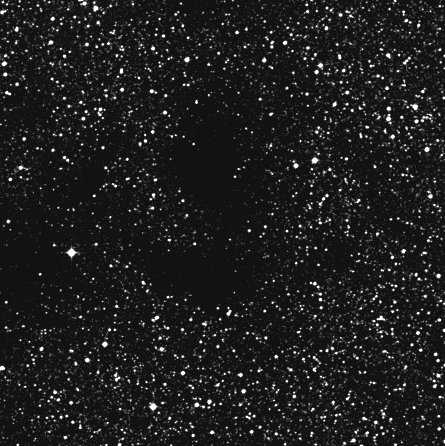 LDN 470 in POSS-red. image is 0.25 deg on a side. --Rebull 14:09, 14 January 2008 (PST)
LDN 470 in POSS-red. image is 0.25 deg on a side. --Rebull 14:09, 14 January 2008 (PST)
--Mcdonald 15:39, 15 January 2008 (PST) Hi, here is a colored image of LDN 470:
LDN 1225
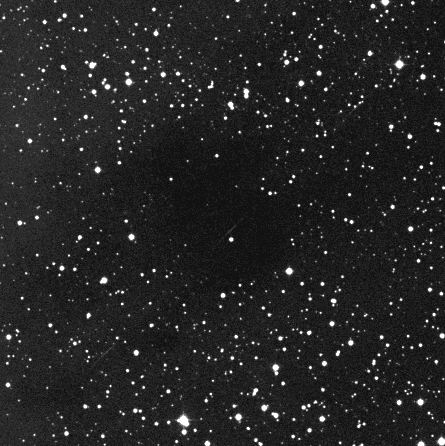 LDN 1225 in POSS-red. image is 0.25 deg on a side. --Rebull 14:09, 14 January 2008 (PST)
LDN 1225 in POSS-red. image is 0.25 deg on a side. --Rebull 14:09, 14 January 2008 (PST)
--Mcdonald 15:44, 15 January 2008 (PST) Here is a 15 arcmin x 15 arcmin colored image of ldn1225:
LDN 880
LDN 880 in POSS-red. image is 0.25 deg on a side. Still a little worried that this is too optically thin to make a good Spitzer image. but maybe we could focus very specifically on the dark thing to the southwest.
--Rebull 14:09, 14 January 2008 (PST)
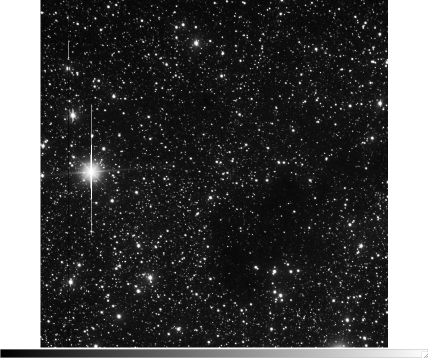
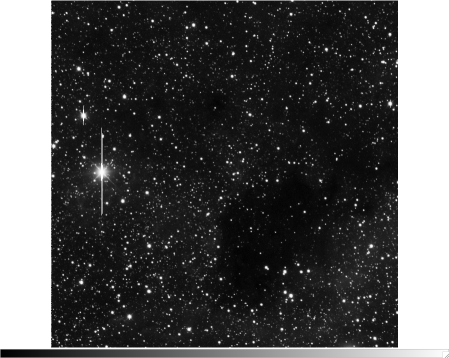 - LDN 880, about the same scale, in relatively deep I and R from the USNO 1.0m.
--Rebull 14:43, 14 January 2008 (PST)
- LDN 880, about the same scale, in relatively deep I and R from the USNO 1.0m.
--Rebull 14:43, 14 January 2008 (PST)
--Mcdonald 15:47, 15 January 2008 (PST) Here is John's colored image made in Austin again 15 x 15 arcmin:
LDN 1340
LDN 1340 in POSS-red. image is 0.25 deg on a side. --Rebull 14:09, 14 January 2008 (PST)
--Rebull 20:14, 8 January 2008 (PST) Here's a summary of the latest developments on this object:
One of you (Peter?) suggested this object - and it was a fabulous suggestion. Beautiful in the optical, with IRAS sources, a handful of existing literature, and no Spitzer. Perfect! The icing on the cake was that it's visible in the Spring.
One of you (Peter again?) noticed that there was another AAS poster from 2005 on this object. I mentioned that I knew 2 of the authors (JoAnn O'Linger and Grace Wolf-Chase). Not 2 hours after leaving you, I ran into them. One thing I didn't mention in the context of searching the archive is that there is an open call for proposals out now, eg., there are ~700 proposals for objects that are currently being reviewed, and 20% of them will get their targets approved by March. To some extent, since you're putting in a proposal more or less now, you kind of trump them. On the other hand, it's never good to make enemies.... So, it turns out that JoAnn and collaborators have submitted a proposal to map this region over 1 square degree. There's no guarantee that their data will actually be taken this cycle (before we run out of cryogen in Spring 2009), but at the same time, we probably won't be able to ask for a full square degree (it would take too much time). We could pick a subregion to focus on, or we could find another target entirely.
I'll continue to talk to JoAnn (we had just a brief conversation today), and if I can get her posters (one from before, one from this meeting!), I'll post them here.
[END]
--Guastella 20:48, 8 January 2008 (PST)
In case we are still looking at this here is the 2005 Abstract
Submillimetre Observations of an Intermediate-Mass Star Forming Cloud Core J. O’Linger, G. H. Moriarty-
Schieven, and G. A. Wolf-Chase
--Rebull 09:37, 9 January 2008 (PST) I talked to JoAnn again today, and she thinks that maybe doing just a piece of the cloud would be a good idea. She showed me some of her supporting data, and indeed this is a really cool area. We could do just a part of it now, and eventually, she'll map the rest of the cloud as well.
Here's her poster from today: Media:joann2008poster.pdf
[END] --Mcdonald 15:51, 15 January 2008 (PST) 15 x 15 colored image:
LDN 951
From: cdewolf@chsd.us
How does LDN 951 look? Assuming I did my query right, it also hasn't been looked at by Spitzer. I found it on a list of LDNs that have visual opacities of 6 in a paper by Visser et. al, 2002. There's another, but it doesn't look as interesting.
Cris L. DeWolf
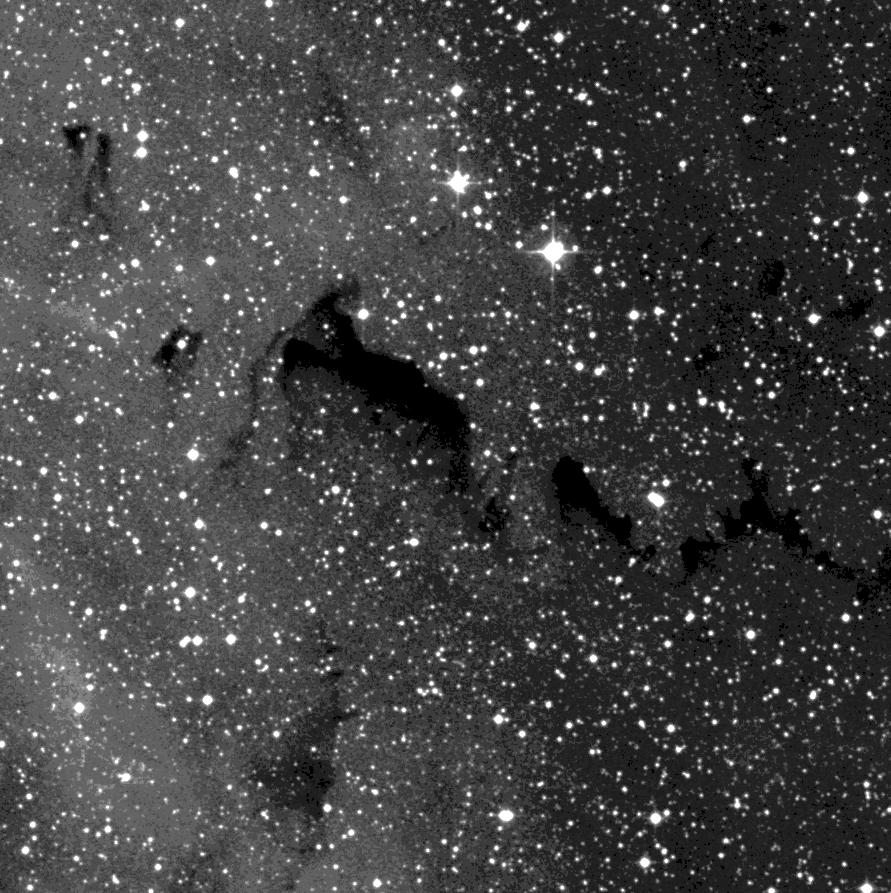
--Rebull 14:00, 9 January 2008 (PST) ooh, this is a nice one! you're right, it doesn't have any Spitzer observations yet. This might very well be a good candidate! [END]
--Dewolf 06:00, 12 January 2008 (PST)There was a study of IRAS associations with dark clouds (Parker, N.D., 1988) that appears to indicate a good chance of there being a YSO in LDN 951. Here's a link to the article. [1] [END]
--Mcdonald 15:54, 15 January 2008 (PST) A 15 x 15 arcmin colored image:
Other targets
--Rebull 11:42, 9 January 2008 (PST) I found two posters today on Lynds clouds - L1221 and L988e. L1221 has Spitzer data which is pretty cool; L988 doesn't have any Spitzer data. Take a look at the other bands and references and see if it would be interesting.... [END]
--Rebull 14:09, 14 January 2008 (PST) nevermind; the L988 image is pretty much just a star field. [END]
--Rebull 14:27, 14 January 2008 (PST) just for comparison, here is a spitzer composite image of L1014. we'd be very lucky to find something like this, but this is the hope. [END]
--Rebull 13:44, 14 January 2008 (PST) David added some general target selection stuff to the talk page [END]
--Rebull 10:48, 15 January 2008 (PST) Out of David's top 16 suggestions, the only ones wihtout existing spitzer data are ldn
1357 (right on the edge of some existing spitzer data) and ldn 1358. you must be doing something right, as you're hitting popular objects. ;) [END]
--Rebull 14:19, 21 January 2008 (PST) but really from jan 20: tim sent this in email:
I have been doing some looking at the Lynds targets. I'm attaching pics of LDN 1598 and LDN 1340. I could not find anything in ADS about either of these targets, so it looks like they have not been studied a great deal. I like the fact that you have a dark area next to a fairly rich star field (especially with 1598). This would tend to indicate a dense nebulous area. the images are 5'x5'. (targets suggested by Tim Spuck)
here's the graphics: (L1598 first, then L1340):
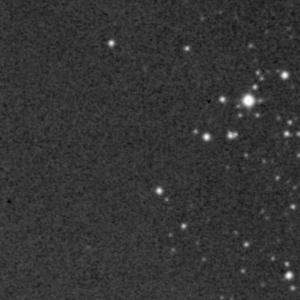
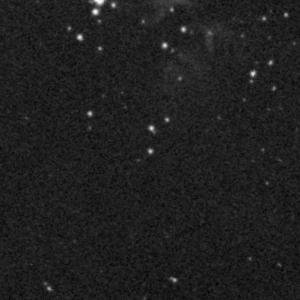
--Rebull 14:26, 21 January 2008 (PST) actually, i get 19 references for ldn 1598, and 15 for L1340, both using simbad... [END]
--Spuck 05:37, 22 January 2008 (PST) Luisa, just for future reference, I thought ADS was a more complete database for identification of current research. I assume this is not the case since you found many references in simbad. Is that correct? Thanks, Tim [END]
--Spuck 06:57, 22 January 2008 (PST) Ok ... I think I may have answered part of my question. I was seaching on LDN1598 and coming up with nothing, but if I search on L1598 or L1340 I am at least coming up with something in ADS (one for 1598, and seven for L1340). I need to play with the parameters a bit. [END]
--Rebull 17:57, 22 January 2008 (PST) they're different sorts of databases, with different strengths and weaknesses. ADS is driven by the literature itself, whereas SIMBAD is driven more by object lists. ADS is usually more complete. But, for example, some of the references for L1685 don't actually call it L1685 anywhere in the paper. ADS may or may not have the information that those papers really do have data about that object - sometimes ADS knows, and sometimes ADS doesn't. Someone at the SIMBAD end did realize (or at least THINKS) that the objects are the same, and has (hopefully correctly) tied the object to the paper. SIMBAD often requires a human to make the association between synonyms for certain objects, and this can be fallible, especially for the more obscure objects. ADS is generally more accurate in the following sense - SIMBAD may quote a spectral type, but to be sure that whatever object you are looking at really has that type, track down the original papers and make sure that the actual original paper really does cite that type. More obscure papers are rarely in SIMBAD, but they can be found in ADS. ADS and SIMBAD are heavily interlinked, so there's a lot of ways to get between them. [END]
--Dewolf 22 Jan 2008 10:19:06 (question submitted via regular email): I'd seen some images [before] with the large pixel areas as well. How do you find a potential IRAS source in a small LDN with such poor resolution? [END]
--Rebull 10:19, 22 January 2008 (PST): Your question really has a two-part answer.
The first part is that I'm not detecting sources by eye. I'm relying upon the computer-generated IRAS Point Source Catalog (PSC) and Faint Source Catalog (FSC) which are described along with the rest of the IRAS mission information here: http://irsa.ipac.caltech.edu/IRASdocs/iras.html
If you get into the documentation, you will find that the catalog consists of, among other things, measurements at each of the 4 IRAS wavelengths, and a quality flag for each of the 4 bands. This quality flag is REALLY IMPORTANT, as it tells us whether the computer thought it was a real detection at each band, or just an upper limit at a particular band. Because the resolution of IRAS is so poor, indeed, it can be fooled.
One of the objects in our shortlist below really did have a recognizable clear point source right on the center of the object at 25 um. But, the rest, I agree, I'd be hard-pressed to identify the source by eye. That doesn't mean it's not there, however. The computer is really good at finding real, faint sources. When we go to write this up, we really should pay attention to whether the computer felt it was a point source just at 100 um and not at 12 or 25 um. For this subset of objects, I am cheating a little because several of them have observations at other wavelengths, enough so that I know there's a real source there, so I didn't go check the quality flags for those objects.
The second aspect of the answer is that when we go look with Spitzer, it could very well be that the source dissolves away into background nebulosity, or breaks into pieces. We have an image at 24 um of something in the Perseus star-forming region that appears in the IRAS catalog as a single object, IRAS 03388+3139. But, when we look with Spitzer, it breaks up into 9 objects. This stuff appeared in Rebull et al., 2007, ApJS, 171, 447 (also findable in astro-ph, look near Jan 2007), along with an analysis of what IRAS sources dissolved away completely into nebulosity when viewed with Spitzer. The nebulosity is very complex here, so it happens. [END]
A (The?) Shortlist
Goal: find anywhere from one to a few LDN likely to host young stars so that we not only have a pretty picture but also find some new baby stars. If we are going to ask for more than one cloud, they need to have different properties, so that we can explain that we are looking at THIS sort and THAT sort to compare. And we can (should) also say we will mine the Spitzer archive for more examples.
Luisa's Favorites
| LDN | Image | Notes |
| 951 | 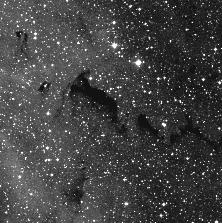 (POSS/Red, 0.25 deg on side) (POSS/Red, 0.25 deg on side)
|
|
| 425 | 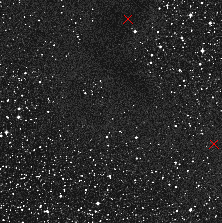 (POSS/Red, 0.25 deg on side) (POSS/Red, 0.25 deg on side)
|
|
| 981 | 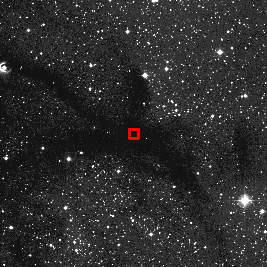 (POSS/Red, 0.3 (not 0.25!) deg on side) (POSS/Red, 0.3 (not 0.25!) deg on side)
|
|
| 1143 | 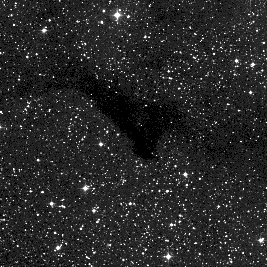 (POSS/Red, 0.3 deg on side - now spot won't let me do 0.25, ??) (POSS/Red, 0.3 deg on side - now spot won't let me do 0.25, ??)
|
|
| 1598 | 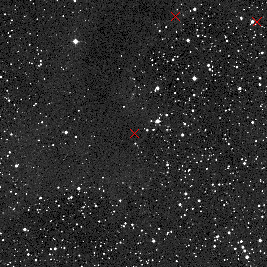 (POSS/Red, 0.3 deg on side - now spot won't let me do 0.25, ??) x's are IRAS sources (POSS/Red, 0.3 deg on side - now spot won't let me do 0.25, ??) x's are IRAS sources
|
|
| 1685 | 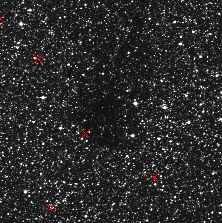 (POSS/Red, 0.25 deg on side) (POSS/Red, 0.25 deg on side)
|
|
the AOR file to load into spot is here: media:lyndsaors.aor.txt - i had to add a ".txt" extension to get the wiki to accept it, but you should save the file to disk and rename it as just ".aor" and then Spot will recognize it as an AOR file.
Middle-of-the-road candidates
Usually they're just here because there's no good reason to reject them, but others seem prettier or more likely to host stars.
- LDN 470 - small, opacity class=6.
- LDN 1225 - bigger, opacity class 4 only (too thin?)
- LDN 1125 - opacity class=5, blotchy/blobby, same as Barnard 152, Lee and Myers say YSO but appears in 'starless core' papers.
- LDN 1139 - opacity class=5, blotchy/blobby, Lee and Myers say YSO but appears in 'starless core' papers.
Rejects, and reasons:
- LDN 880 - lee and myers say no YSO; rather thin in optical images, and might just see through it in spitzer.
- LDN 769 - lee and myers say no YSO; mentioned in several other "starless core" papers.
- LDN 778 - many simbad refs (>40!) but most of them are 'starless core' papers
- LDN 1041 - image looks like a plain star field
- LDN 1082 - image looks like a plain star field
- LDN 1340 - nice image, but consensus from the group was that they wanted to work in a 'new' region.
Voting and Ranking
If the editing of the table in the wiki intimidates you, or you're worried about making sure your vote appears under your column (this can be tricky), feel free to just email me your ranking, and I'll enter it here. "1" is high (most favorite), "6" is low (least favorite). So as not to bias you, I won't put in my votes until the very end.
| LDN | Pete | Chelen | David | John | Cris | Tim | Luisa | AVERAGE |
| 951 | 6 | 5 | 1 | 4 | 5 | 5 | 5 | 4.4 |
| 425 | 2 | 2 | 2 | 2 | 2 | 3 | 2.2 | |
| 981 | 1 | 1 | 2 | 1 | 1 | 1 | 1 | 1.1 |
| 1143 | 3 | 4 | 3 | 5 | 3 | 4 | 2 | 3.4 |
| 1598 | 4 | 6 | 3 | 4 | 3 | 4 | 4.0 | |
| 1685 | 5 | 3 | 6 | 6 | 6 | 6 | 5.3 |
Rank-ordered list is therefore:
- LDN 981 (rank 1.1) - 0.9 hrs spitzer time
- LDN 425 (rank 2.2) - 0.3 hrs spitzer time
- LDN 1143 (rank 3.4) - 0.6 hrs spitzer time
- LDN 1598 (rank 4.0) - 0.6 hrs spitzer time
- LDN 951 (rank 4.4) - 1.2 hrs spitzer time
- LDN 1685 (rank 5.3) - 0.6 hrs spitzer time
I would counsel that you write a proposal for the top two clouds. They have some different properties, and the total time request of 1.2 hrs is not completely outrageous.
--Dewolf 08:54, 29 January 2008 (PST)The paper that Luisa referred to in her discussion of LDN 981 is worth a read as we prepare our proposal. Here is a direct link to a pdf of it media:0610786v1.pdf. The authors suggest that V1331 Cyg evolved from one of the filaments in this linear cloud. To me, this implies a strong possibility of additional YSOs in the cloud. What do you think? [END]
--Rebull 13:02, 30 January 2008 (PST) Yep, i think it's a strong possibility, but also look at the rest of the text i posted above in the entry for 981 :
Quanz et al. (2007, ApJ, 656, 287, also astro-ph/0610786 -- see http://arxiv.org/abs/astro-ph/0610786 for free copy of paper) [...] One of the questions they address in this paper is whether or not V1331 Cyg formed on its own, or with 'friends.' They talk in their paper (see sections 4.2 and 4.3) about whether some objects found in the LDN black parts are real YSOs or not, and they conclude based on available evidence that they are not YSOs. BUT, maybe they just weren't looking in long enough wavelengths. We might find that these stars really are YSOs... or we may not. We may confirm that yes, they are just foreground objects superimposed on the dark lanes of the nebula.
--CJohnson updated 9:00 CDT 02 May 2008
Travel Arrangements
If you want to e-mail me your travel arrangements, I would be happy to update this chart.
| LDN | Pete | Chelen | David | John | Cris | Tim | |
| Arrival date/time | 13-June, 20:08 (LAX) Delta 79 | 13-June, 20:15 (BUR) | 13-June | 13-June, 11:55 (BUR) Canadair 2836 | 13-June, 15:05 (BUR) | x | |
| # of students (male/female) | 1/1 | 0/0 | 1/2 | 0/0 | 2/0 | yes | |
| Hotel** | HIE | HIE | HIE | HIE | HIE | x | |
| Auto rental?? | yes, car | no | personal car | no | no | yes, van | |
| Departure date/time | 17-June 22:50 LAX Delta 648 | 18-June 7:15 | 19-June | 18- June 11:17 LAX United 5435 | 18-June | x |
- HIE=Holiday Inn Express-Pasadena, BW=Best Western Pasadena Royale
Peace, --chj [END]
